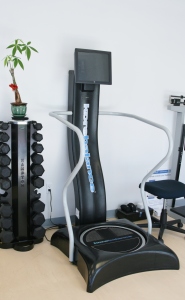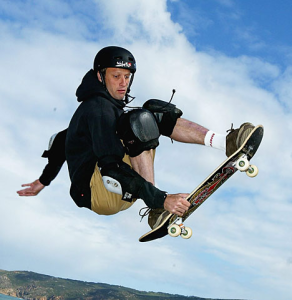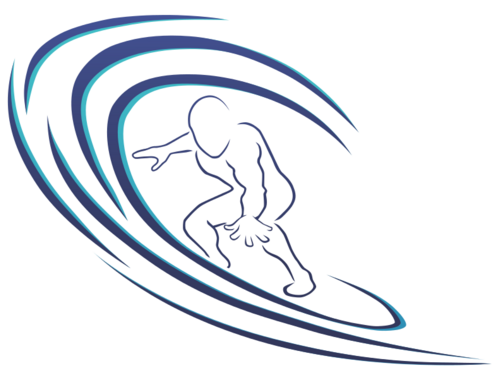 Korebalance™ Balance Training
Korebalance™ Balance Training
Improve strength, balance, flexibility, mobility, and coordination with the Korebalance Training system.
Korebalance™ is an all-in-one device that trains strength, flexibility, mobility, and coordination in a variety of individuals ranging from young military pilots and athletes to elderly osteoporotic patients. Variable Speed Reaction Training is one of its many features that challenge patients by exercising their cognition, vision, and proprioception to fine-tune their balance (2). The patient stands on an “unstable platform” and views a video screen as the Korebalance™ uses virtual simulation and proprioceptive feedback to lead the patient through interactive games with their body serving as the joystick to control actions on the screen.
Balance and coordination training are used in our Osteoporosis prevention and treatment programs.
 The Korebalance™ system is integrated into the osteoporosis prevention and treatment program as well as many sports performance and rehabilitation programs at Pacific Coast Sports Medicine. With this equipment we provide patients with state-of-the-art balance training to reduce the risk of falls and, thereby, further prevent bone fracture and other serious injury that may result from falls.
The Korebalance™ system is integrated into the osteoporosis prevention and treatment program as well as many sports performance and rehabilitation programs at Pacific Coast Sports Medicine. With this equipment we provide patients with state-of-the-art balance training to reduce the risk of falls and, thereby, further prevent bone fracture and other serious injury that may result from falls.
Why should one improve their balance?
Of the fractures sustained by osteoporotic patients, hip fractures are the most serious, physically debilitating, and costly. It is estimated that around $37,000 is spent per patient on hip fracture surgery and treatments (5). Hip fractures frequently lead to deterioration of overall health and loss of independence of the individual. While not all falls are due to poor balance, practitioners at Pacific Coast Sports Medicine take a whole body approach to the wellbeing and enhancement of coordinated muscular movement of our patients.
Studies have demonstrated that balance training improves other aspects of life, such as brain function and gait speed.
In addition to improving balance, clinical studies have demonstrated that balance training that incorporates motor imagery as well as interactive cognitive-motor training enhances gait speed, executive functioning of the brain, overall function and mobility (1,3,6). It has been shown that 12 weeks of proprioception training improves postural stability as well as static and dynamic balance (4). These training outcomes are not just beneficial for the elderly or osteoporotic patients; athletes of all ages can improve their performance and sports-specific actions with balance training. Athletes who have a stable and strong core can maximize their movements confidently in training workouts as well as strength and conditioning sessions, ultimately translating into better performance in competition settings.
Whether you are post-surgery and undergoing rehabilitation, an athlete looking to enhance performance, or osteoporotic with high risk of fracture, professional medical practitioners at Pacific Coast Sports Medicine can develop the most effective programs to suit your needs. Through the use of Korebalance™, patients’ balance improves as they enhance their coordination, agility, motor control, reflexes, and reaction time in a safe and fun environment.
- Cho HY, Kim JS, Lee GC. Effects of motor imagery training on balance and gait abilities in post-stroke patients: a randomized controlled trial. Clin Rehabil. 2013;27(8):675-80.
- Korebalance Presentation PDF. Medical Device Depot Web site. http://www.meddevicedepot.com/PDFs/korepresentation.pdf. Accessed December 3, 2014.
- Liao CD, Liou TH, Huang YY, Huang YC. Effects of balance training on functional outcome after total knee replacement in patients with knee osteoarthritis: a randomized controlled trial. Clin Rehabil. 2013;27(8):697-709.
- Martinez et al. Effects of 12-week proprioception training program on postural stability, gait, and balance in older adults: a controlled clinical trial. J Strength Cond Res. 2013;27(8):2180-8.
- OrthoInfo Web site. http://orthoinfo.aaos.org/topic.cfm?topic=A00232. Accessed December 1, 2014. Modified August 2009.
- Schoene D, Valenzuela T, Lord SR, De Bruin ED. The effect of interactive cognitive-motor training in reducing fall risk in older people: a systematic review. BMC Geriatrics. 2014;14:107.
CLICK HERE for Korebalance™ website
